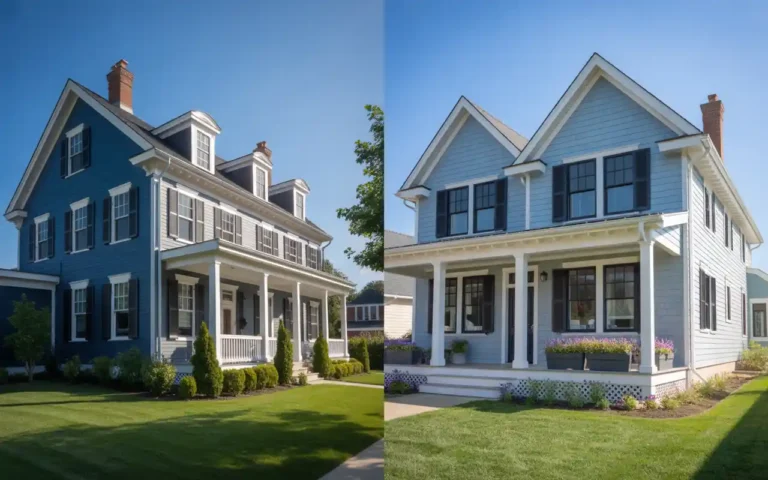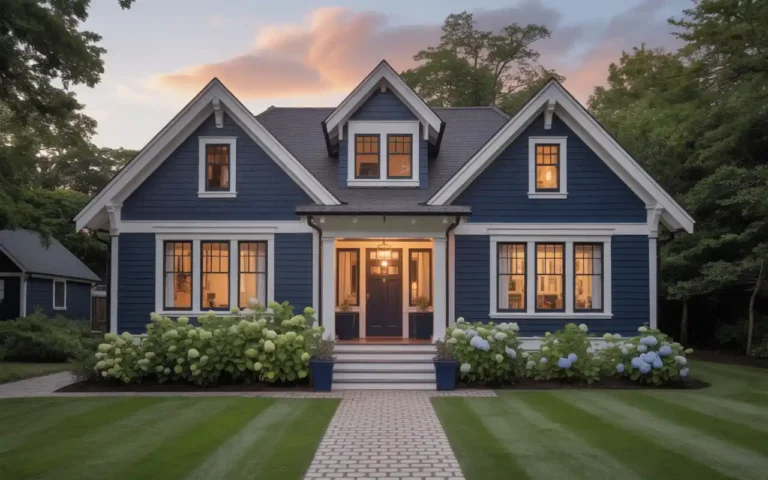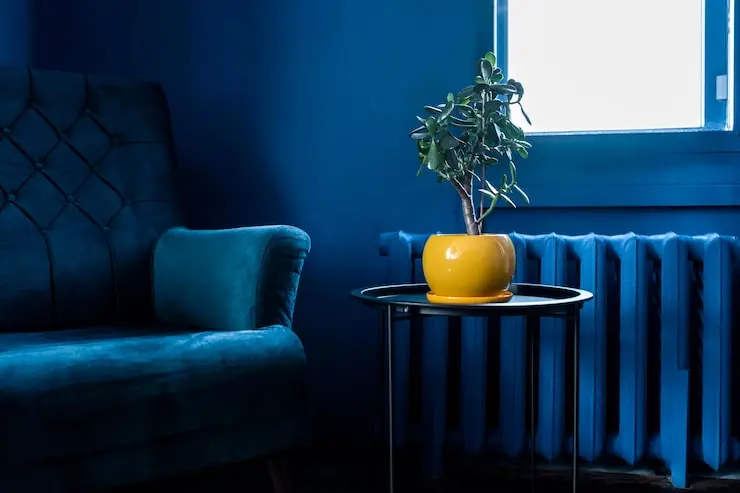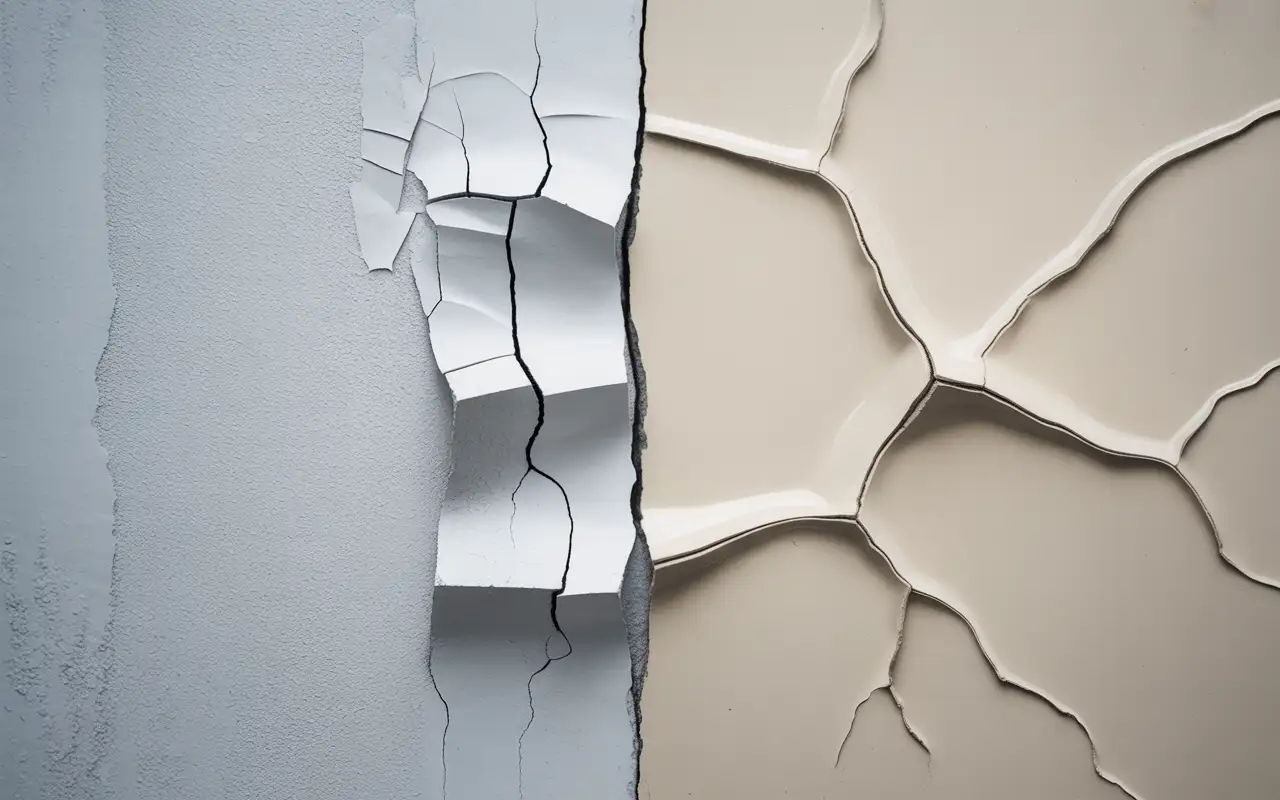Picking the right shade of blue paint for the outside of your house can quickly improve its curb appeal. Blue siding colors for homes look great with a lot of different architectural types and with natural materials like stone, brick, and wood. The best exterior blue paint colors range from deep navy tones to soft seaside tones that bring out its unique style.
There aren’t many paint colors that are as versatile as blue. You can use it to change the color scheme of your current home or give the outside a full makeover. The right shade of blue for your home’s exterior relies on its style, the lighting, and the landscape around it. Dark blues can be dramatic, while light blues can be cool and soothing.
Table of Contents
ToggleIs Blue a Good Color for Exteriors?

When it comes to style and functionality, blue exterior paint is one of the best options for residents. Shades of blue, unlike neutral grays or whites, add flair while still having a high resale value. Blue paint for the outside of a house looks great with red brick, natural stone, and wooden accents.
The color blue makes people feel calm and safe, which makes it a great choice for the outside of your house. During the day, blue paint changes how it looks depending on the light. It looks darker in the darkness and brighter in the sun. This ability to change helps blue stay interesting to look at without being too much.
Climate and Durability Considerations
The weather where you live has a big effect on how blue outdoor paint colors last over time. Colors look 4 to 5 times brighter outside than they do in places with a lot of sunlight or high elevation. In the south, where the sun is strong, some blue colors may fade more quickly than others.
In the north, where there is less direct sunlight, darker blues can keep their color without looking too much. Blue naturally goes well with ocean and sky tones, which is great for places near the coast. When choosing between light and dark choices, think about the weather in your area to get the most out of them.
#1 // Needlepoint Navy by Sherwin Williams

Needlepoint Navy offers the perfect balance between bold navy and subtle sophistication. With an LRV of 13, this color provides dramatic impact without appearing too dark or harsh. The undertones lean slightly warm, making it compatible with various exterior materials including brick, stone, and wood trim.
This versatile navy works beautifully on both traditional and contemporary home styles. Pair it with crisp white trim for classic contrast, or choose warm off-white shades for a softer appearance. Needlepoint Navy particularly shines on homes with natural landscaping, as the color complements green foliage naturally.
For architectural details, consider using lighter blue-gray shades as accent colors. This creates depth and visual interest while maintaining color harmony. The color performs well in various lighting conditions, appearing rich and sophisticated throughout different times of day.
#2 // Hale Navy by Benjamin Moore

Hale Navy stands as one of the most popular navy paint colors for good reason. This complex dark blue contains muted gray tones that prevent it from appearing flat or monotonous. Despite looking nearly black on paint chips, Hale Navy reveals its rich blue character when applied to exterior surfaces.
The sophisticated blend works exceptionally well with copper accents, wood elements, and natural stone features. White trim creates stunning contrast that enhances architectural details. For front door options, consider warm colors like deep red or forest green to complement Hale Navy’s undertones.
This color adapts beautifully to different architectural styles, from historic colonials to modern farmhouse designs. The muted quality ensures it won’t compete with landscaping or hardscaping elements while providing an elegant backdrop for your home’s features.
#3 // Naval by Sherwin Williams
For those seeking an even deeper navy option, Naval delivers dramatic sophistication with an LRV of only 4. This near-black navy contains subtle purple undertones that create stunning depth and richness. The color works particularly well with natural stone and plants featuring purple or burgundy tones.
Naval’s intensity allows for bolder accent colors that might overpower lighter blues. Consider vibrant front door colors like chartreuse or coral for contemporary appeal. The dark base provides excellent contrast for highlighting architectural details in lighter colors.
This color choice works best on homes with ample natural light or interesting architectural features that benefit from dramatic emphasis. The deep tone creates a striking backdrop that makes landscaping and accent colors appear more vibrant by comparison.
#4 // James Hardie Evening Blue
James Hardie’s Evening Blue comes factory-finished on their fiber cement siding, offering convenience and consistency. This dramatic navy brings instant sophistication to split-level homes and contemporary designs. The baked-in finish provides superior durability compared to field-applied paint options.
Evening Blue pairs beautifully with copper and wood accents for rustic appeal, or with light gray and off-white combinations for sleek, modern aesthetics. The pre-finished option eliminates concerns about color matching and ensures even coverage across all siding pieces.
Consider this option if you’re installing new siding and want guaranteed color consistency. The factory finish typically outlasts field-applied paint, making it an excellent long-term investment for your home’s exterior.
#5 // Bravo Blue by Sherwin Williams
Bravo Blue represents the lighter end of the blue spectrum while maintaining enough color intensity to create visual impact. This pastel tone works particularly well for coastal homes or properties where you want color without overwhelming the architecture. The light tone pairs beautifully with white trim for clean, crisp contrast.
This airy blue gray option brings refreshing energy to traditional home styles while maintaining sophisticated appeal. The color works exceptionally well in bright, sunny climates where darker colors might appear too intense. Beach house aesthetics benefit greatly from this soft, welcoming shade.
For accent colors, consider natural wood tones or soft gray options that complement rather than compete with the gentle blue base. This creates a serene, coastal-inspired palette that feels both current and timeless.
#6 // Palladian Blue by Benjamin Moore
Palladian Blue captures the essence of sky and water in a sophisticated paint color perfect for waterfront properties. This ideal sky-blue shade creates light, refreshing appeal when paired with white accents and natural materials. The color evokes coastal serenity while maintaining enough sophistication for upscale homes.
Light gray stone and white trim create the perfect complement to Palladian Blue’s gentle intensity. The combination feels fresh and contemporary while remaining classic enough for long-term enjoyment. This color particularly benefits homes with significant natural light and ocean or lake views.
Consider using this color for homes with interesting architectural details that benefit from lighter colors to highlight features. The soft intensity won’t compete with detailed millwork or decorative elements.
#7 // Westcott Navy by Benjamin Moore
Westcott Navy reads more like a dark gray with strong blue undertones, offering versatility that pure navy colors can’t match. When paired with darker accent colors, it emphasizes the gray aspects. Combined with lighter tones, the navy characteristics become more prominent.
This adaptable color works beautifully on historic homes where you want sophistication without appearing too bold. The muted quality fits well within established neighborhoods while providing enough character to stand out appropriately. Natural landscaping enhances Westcott Navy’s sophisticated appeal.
The color’s flexibility makes it an excellent choice for homes with mixed materials or complex architectural details. It provides a sophisticated backdrop that allows other elements to shine while maintaining a strong color presence.
#8 // James Hardie Boothbay Blue
Boothbay Blue from James Hardie offers a lighter alternative to their Evening Blue option. This soft blue works perfectly for waterfront properties or homes where you want gentle color impact. The factory-finished option ensures consistent color and superior durability.
Paired with white and wood accents, Boothbay Blue creates serene aesthetics ideal for coastal or lakefront homes. The soft intensity works well in bright climates where darker colors might overwhelm the architecture. This option particularly suits homes with significant natural light.
The pre-finished convenience eliminates color-matching concerns while providing professional-quality results. Consider this option for new construction or complete siding replacement projects where consistency and durability are priorities.
#9 // Raccoon Fur by Benjamin Moore
Raccoon Fur represents the bold end of blue exterior options with its rich, inky character. This near-black paint contains strong blue and violet undertones that create unique character for dramatic home exteriors. The complex color requires careful consideration but delivers stunning results when properly applied.
The strong undertones work beautifully with purple or burgundy landscaping elements. White trim provides necessary contrast to highlight architectural details. This bold choice works best on homes with interesting features that benefit from dramatic emphasis.
Test this color thoroughly before committing, as the strong undertones can appear different in various lighting conditions. The dramatic intensity makes it an excellent choice for homeowners seeking distinctive curb appeal that stands out from typical neutral options.
#10 // Aleutian by Sherwin Williams
Aleutian offers charming, cool blue character perfect for traditional homes seeking a colorful personality. The mid-range LRV value of 39 makes it versatile for pairing with both dark and light accent colors. This balanced intensity provides color impact without overwhelming architectural features.
Traditional home styles benefit greatly from Aleutian’s classic blue appeal. Dark front doors and shutters with white trim create timeless combinations that enhance curb appeal. The cool undertones work particularly well with gray stone and contemporary materials.
This color choice offers excellent versatility for homeowners who want blue character without committing to very dark or very light options. The balanced intensity adapts well to different lighting conditions throughout the day.
Understanding Undertones in Blue Paint
Blue paint colors often carry green, gray, or violet undertones. This can shift how they look in sunlight or shade.
- Blue-green tones feel fresh and coastal.
- Blue-gray tones create elegance and subtlety.
- Blue-violet tones add richness and depth.
Knowing undertones helps avoid surprises once the color is in your home. Always sample a few shades before making a final decision.
Why LRV Matters for Exterior Colors
LRV, or Light Reflectance Value, measures how light or dark a color appears.
- Low LRV (0–20) = very dark, bold shades like Naval.
- Medium LRV (20–50) = balanced colors like Aleutian.
- High LRV (50+) = light, airy shades like Palladian Blue.
This matters because exterior color changes throughout the day. Considering LRV helps predict how blue paint colors will look under different lighting.
Testing Exterior Blue Paint Colors
Never pick paint based on a digital swatch alone. Colors shift with light, shadows, and surroundings. Use peel-and-stick samples or painted boards outdoors. Look at them morning, noon, and evening.
This small step ensures you choose the right blue for your home’s conditions. Both James Hardie baked-in colors and brands like Benjamin Moore and Sherwin-Williams can be sampled before committing.
Have You Found the Blue You're Looking For?
Selecting the perfect blue exterior paint color requires balancing personal preferences with practical considerations like climate, architecture, and neighborhood aesthetics. Each of these carefully chosen options offers unique benefits for different home styles and situations.
If you need professional guidance for your exterior painting project, San Diego Custom Painting provides expert color consultation and application services. Our experienced team understands how different blue paint colors perform in various conditions and can help you achieve stunning results. For comprehensive exterior painting services in San Diego, we offer complete solutions from color selection through final application.
Remember that paint samples look different in various lighting conditions, so always test your chosen color on your home’s exterior before committing to the full project. The investment in proper testing prevents costly mistakes and ensures satisfaction with your final results.
FAQs
What is the most popular blue exterior paint color?
Hale Navy by Benjamin Moore consistently ranks as the most popular blue exterior paint color due to its sophisticated blend of navy and gray tones that work with various architectural styles.
Do dark blue exterior colors fade faster than light colors?
Dark blue exterior paint colors may show fading more noticeably than lighter options, but high-quality paints with UV protection maintain color integrity for 10-15 years with proper application.
What trim colors work best with blue exterior paint?
Warm off-white colors like Classic Gray, Natural Choice, and Pale Oak create sophisticated combinations with blue exterior paint. Avoid bright white, which creates harsh contrast.
How do I know if blue paint has warm or cool undertones?
Blue paints with green undertones appear warmer, while those with violet undertones feel cooler. Gray undertones create sophisticated, muted appearances that work with various accent colors.
Should I choose pre-finished siding or field-applied paint?
Pre-finished options like James Hardie colors offer superior consistency and durability, while field-applied paint provides unlimited color choices and lower upfront costs.
How does climate affect blue exterior paint performance?
High-altitude and southern climates make colors appear brighter and may cause faster fading. Northern climates allow darker colors to maintain richness without appearing overwhelming.
What architectural styles work best with blue exterior paint?
Blue exterior paint works well with all architectural styles, from Victorian and colonial to contemporary and farmhouse designs. The key is selecting the right shade intensity for your specific style.





